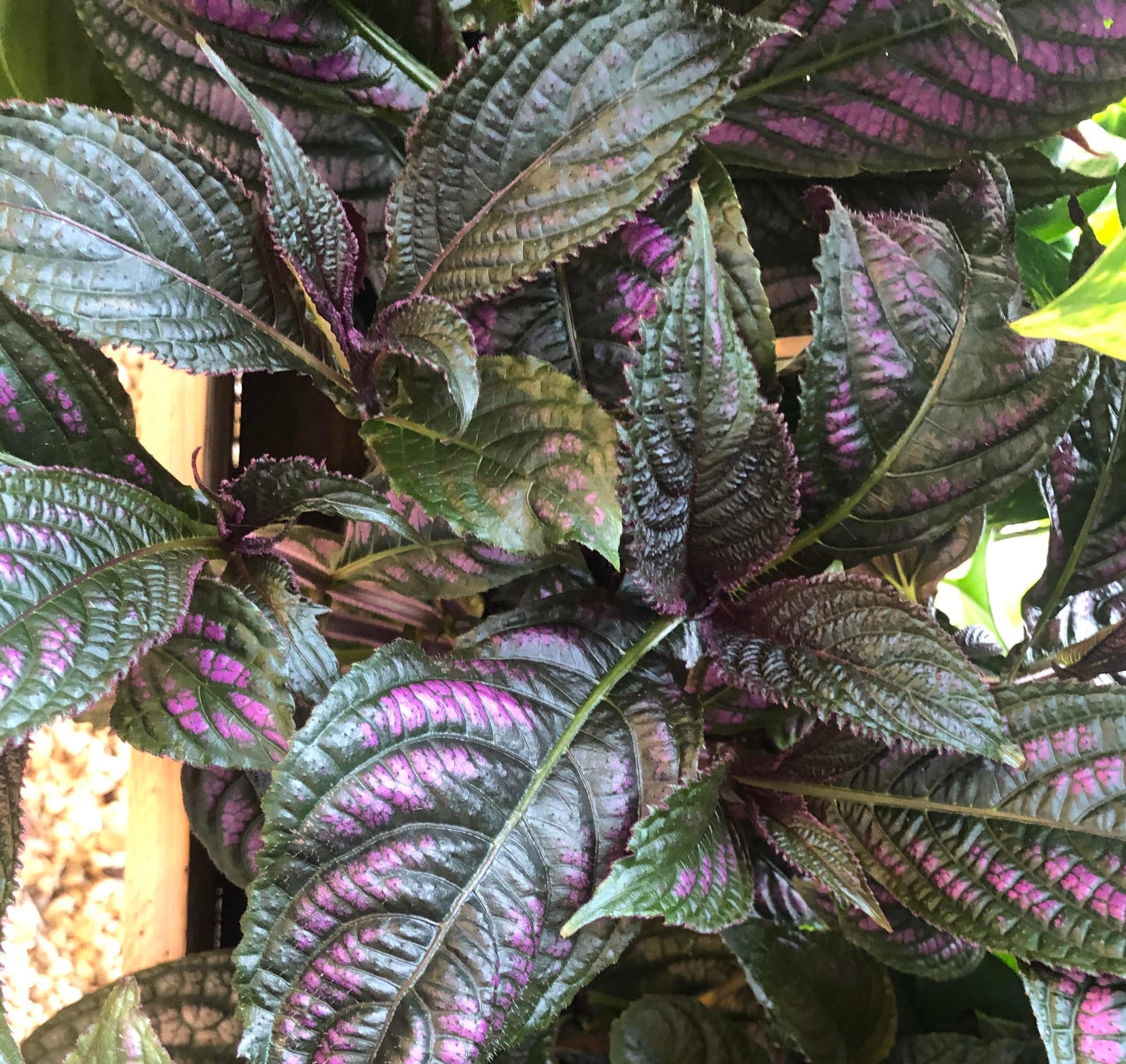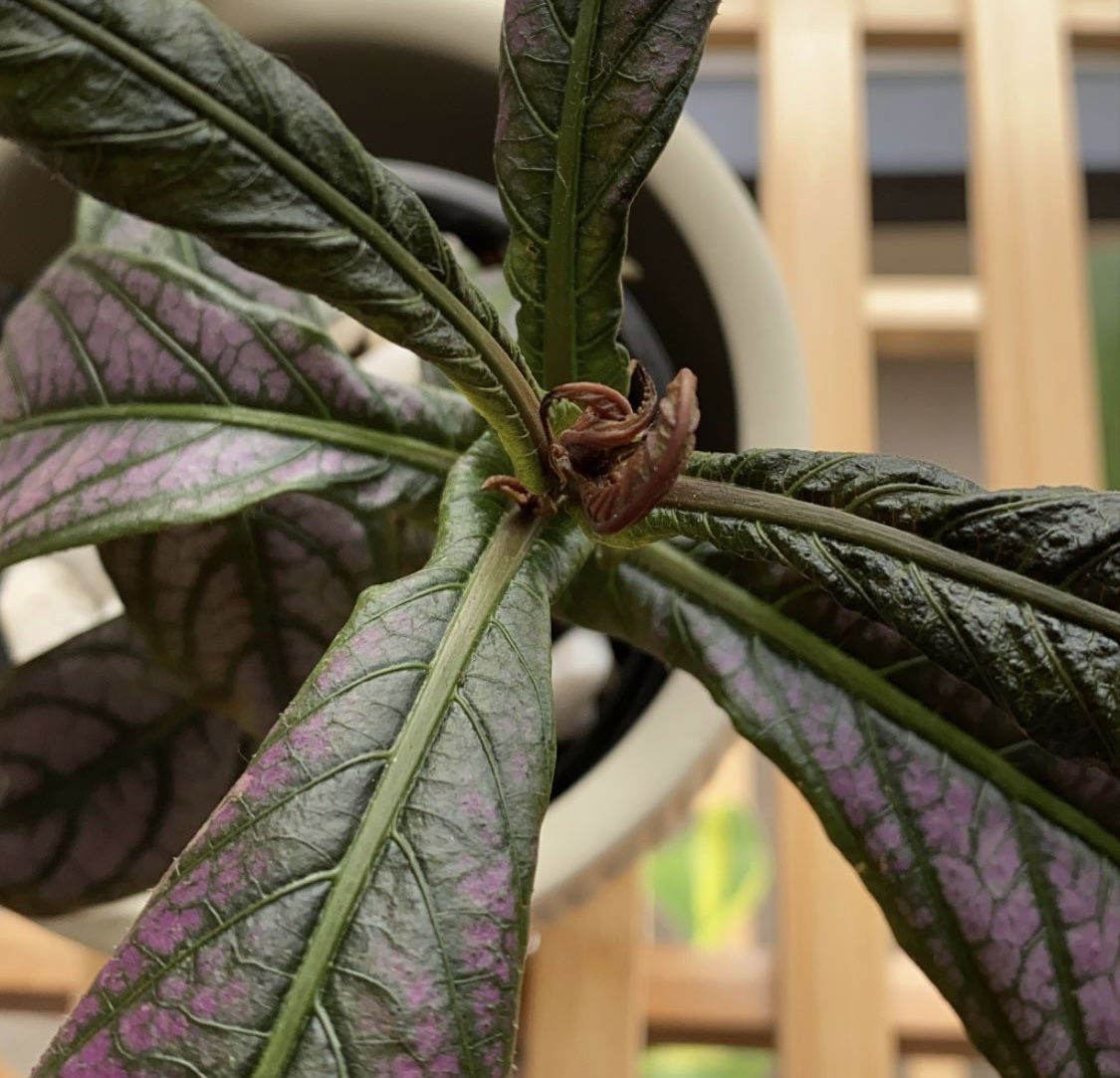
Strobilanthes auriculata var. dyerianus.
Contents
- Top Tips
- Location, Water, Humidity & Fertilisation
- Common Issues
- Origins, Temperature, Propagation, Repotting & Toxicity.
Need the answer to a specific plant query? Book a 1-to-1 video call with Joe Bagley, the website's friendly author, to overcome and address your niggling problem! Available on iMessage, WhatsApp, Facebook Messenger & more.
Top Tips & Info
- Care Difficulty - Moderate
- Persian Shields like to be kept in a bright location, with the possibility of either morning or evening sun. Avoid deep shade at all costs due to the risk of over-watering and a loss of variegation.
- Provide relatively moist soil, allowing the soil's top third to dry out in between waters. Reduce irrigations slightly further in the height of the autumn and winter to reinforce its dormancy.
- Fertilise using a 'Houseplant' labelled feed every four waters in the spring and summer, reducing this to every six in the colder months.
- Repot every three years in the spring, using a 'Houseplant' labelled potting mix and the next sized pot.
- Keep an eye out for Spider Mites & Mealybugs that'll hide in the plant's cubbyholes and underneath the leaves.
Location & Light - 🔸🔸
In order to maintain its healthy variegations (leaf patterns), a bright location is advised. We'd recommend situating yours in a bright, indirect location with the possibility of morning or evening sun. A north, east or west-facing window or beneath a light source (like skyline windows or grow lights) is the optimum setting for a Persian Shield. Remember, the brighter the location, the more watering you'll need to do to ensure thorough hydration.
Water - 🔸🔸🔸
Persian Shields are best kept in reliably moist soil, as inconsistent moisture levels may result in stunted growth and an unhappy plant. Allow the compost's top third to dry out in between waters in the growing period, reducing this further in the autumn and winter. Under-watering symptoms include yellowing or wilting leaves, stunted growth and dry, crispy patches forming on the leaf edges - these issues are usually caused by too much light/heat or forgetfulness. Over-watering symptoms include a weakened or rotten stem, no new growth, yellowing lower leaves and eventual plant death - click here to learn more about root rot and how to address it!
Humidity - 🔸🔸🔸
Create a humidity tray to provide a moist and stable environment for your plant. If the surrounding saturation is too low or the heat too high, its leaf-tips may start to brown over and curl, especially in direct sunlight. Gently hose the foliage down from time to time to hydrate the leaves and keep the dust levels down.
Fertilisation - 🔸🔸
Feed every four waters during the growing period and every six in the autumn and winter, using a 'Houseplant' labelled fertiliser. Never apply a 'Ready to Use’ product into the soil without a pre-water first, as it may burn the roots and lead to yellowed leaves.
Common Issues with Persian Shields
Yellowing lower leaves could be a sign of over-watering, but equally is a byproduct of maturity. If the older leaves rapidly become yellow in quick succession, over-watering could be to blame. People don't realise that a plant's root system needs access to oxygen too; when soil is watered, the air will travel upwards and out of the potting mix. A lack of accessible oxygen for the roots will cause them to subsequently breakdown over the oncoming days. Click on this link to learn more about root rot and how to address it.
If your specimen is located in a dark environment with mould developing on the compost's top layer, use a chopstick to stab the soil in various areas gently. You should aim to enter the compost between the base of the plant and the pot's edge, as failure to do so may lead to damaging its lower portion. Leave the holes open for a few days before re-surfacing the soil to avoid it becoming overly dry. Not only will the gentle shift in the soil's structure mimic the work of small invertebrates in the wild (worms, etc.), but it'll also add oxygen back into the soil, thus reducing the risk of root rot. Repeat this monthly, or whenever you feel the potting-mix isn't drying out quickly enough.

Curled leaves and brown leaf-edges are the result of too little water and sometimes over-exposure to the sun. Persian Shields are best located in bright, indirect settings, and those that haven't acclimatised to the harsh rays will show signs of sun-scorch and environmental shock. A splash of winter sunlight is acceptable as long as the soil moisture is regularly observed, with complete avoidance once summer comes along. If you're a forgetful waterer, we recommend creating a watering schedule for weekly drinks.
Never situate it within four metres of an operating heat source, for instance, a heater or fireplace. Due to the heightened temperature, the plant will soak up far more moisture than those situated in cooler locations, increasing the chance of droughts and browning leaf-edges.
Origins
Strobilanthes dyerianus was first described by Maxwell Tylden Masters in the 1890s, before being reclassified as a variety of the species, Strobilanthes auriculata, in 2003. Strobilanthes comes from the Greek words strobilos meaning a cone and anthos meaning a flower, that refers to the flower-head of some species. The specific epithet of Dyerianus honours Sir William Turner Thiselton-Dyer, Director of the Royal Botanic Gardens in Kew, from 1885 until late 1905. Auriculata can be translated from Latin to mean 'having two lobes', in reference to its ear-like leaves. The species has natural distributions across central-east Asia, ranging from China to southern Thailand.
 The Distribution of Strobilanthes dyerianus.
The Distribution of Strobilanthes dyerianus.
Temperature
15° - 27℃ (57° - 80℉)
H1b (Hardiness Zone 12) - Can be grown outdoors during the spring and summer in a sheltered location whilst nighttime temperatures are above 15℃ (59℉), but is fine to remain indoors, too. If you decide to bring this plant outdoors, don't allow it to endure more than an hour of direct sunlight a day as it may result in sun-scorch. Regularly keep an eye out for pests, especially when re-introducing it back indoors.
Spread
The overall size can be up to 0.8m (3ft) in height and 0.6m (2ft) in width. The ultimate size will take between 4 - 6 years to achieve when repotted biannually, with several new leaves unfurling per annum.
Pruning & Maintenance
Remove yellow or dying leaves, and plant debris to encourage better-growing conditions. While pruning, always use clean scissors or shears to reduce the chance of bacterial and fungal diseases. Never cut through yellowed tissue as this may cause further damage in the likes of diseases or bacterial infections. Remember to make clean incisions as too-damaged wounds may shock the plant, causing weakened growth and a decline in health.
Propagation
Via Seed or Stem Tip Cuttings.
Stem Tip Cuttings (Moderate) - This method is an easy way to duplicate the original plant. Stems that are at least 10cm (4 inches) in height and part of an established plant are most successful. To avoid making a mess of the serrations, use a clean pair of scissors and cut 8cm down from the stem's end, dipping the wound in water and then into rooting hormone to speed the propagation. Rooting can take in the range of between two to eight weeks, depending on environmental factors and the cutting's quality. We recommend using a 'Houseplant' labelled potting mix, with a pot that has adequate drainage to avert the risk of blackleg. Provide a bright, warm setting of around 18℃ (64℉) with relatively moist soil, but be sure to allow the top half to dry out in between waters. You'll know if propagation is successful as the leaves will stay green and firm, along with small roots developing from the callous (dried wound). New foliar growth will emerge from the nodes after around twelve weeks, but it may take longer if the conditions aren't optimal. After a month of solid new foliar growth, transplant into a slightly bigger pot and treat it like a mature specimen with the care tips provided above.
Flowers
Persian Shields are part of the Acantha family, which hold plants like Fittonia, Hypoestes & Zebra Plants. With this in mind, your specimen may send-out flower spikes from late spring onwards, holding many flowers within its bracts. Unfortunately, Persian Shields are unlikely to bloom due to the insufficient growing conditions and are therefore grown mostly for its foliage.
Repotting
Repot every three years in the spring, using a 'Houseplant' labelled potting mix and the next sized pot with adequate drainage. Persian Shields are far better potbound for several years due to the heightened risk of root rot and repotting-issues (like transplant shock) - so only repot if you feel it's wholly necessary.
Hydrate the plant 24hrs before tinkering with the roots to prevent the risk of transplant shock. For those situated in a darker location, introduce extra amounts of perlite and grit into the lower portion of the new soil to downplay over-watering risks. Click here for a detailed step-by-step guide on transplantation, or via this link to learn about repotting with root rot.
Book a 1-to-1 video call with Joe Bagley if you'd like a personal guide to repotting your houseplant. This will include recommending the right branded-compost and pot size, followed by a live video call whilst you transplant the specimen for step-by-step guidance and answer any further questions!
Pests & Diseases
Keep an eye out for mealybugs, aphids, spider mites, scale, thrips & whitefly. Common diseases associated with this species are root rot, red leaf-spot, heart rot, botrytis & southern blight - click here to learn more about these issues.
Toxicity
Not known to be poisonous when consumed by pets and humans. If large quantities are eaten, it may result in vomiting, nausea and a loss of appetite.
Retail Locations
Online Stores.
Book a 1-to-1 Call with Joe Bagley
If you need further advice with your houseplants, book an advice call with ukhouseplants' friendly and expert writer today! This can be done via a video or audio call on most apps, including Facebook, FaceTime & Skype. A ten-minute call costs £5.99 (US$7), or £15.99 for thirty minutes. You can ask multiple questions, including queries on plants, pests, terrariums, repotting advice and anything in between. Please consider supporting this service to keep ukhouseplants thriving!